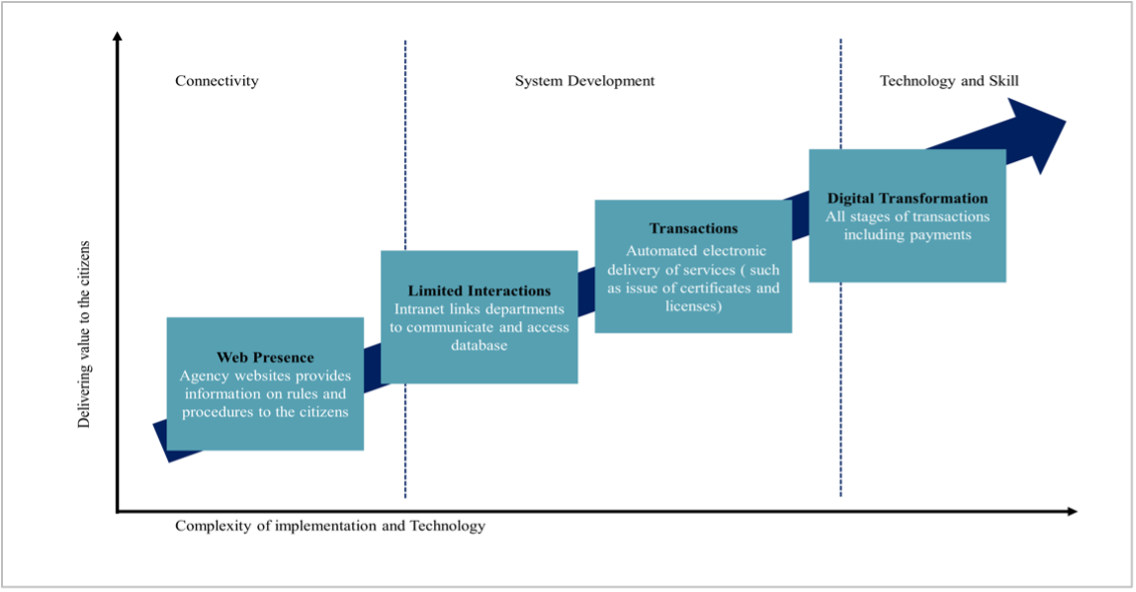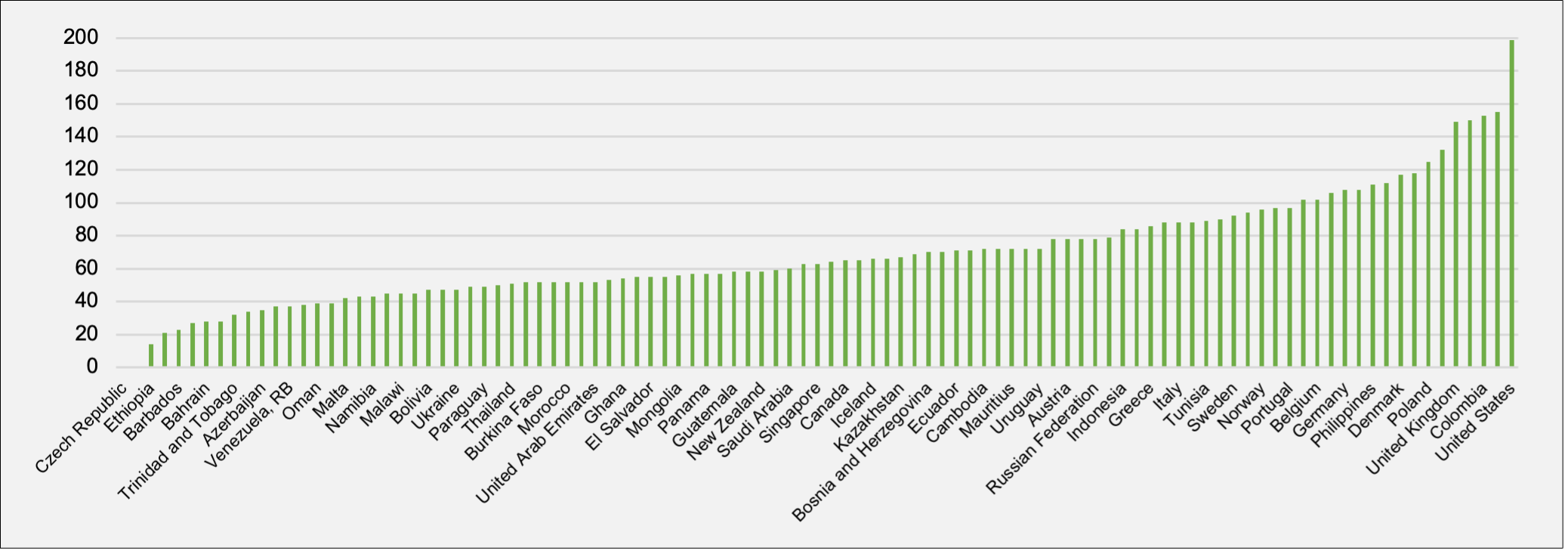
Governance encompasses the decision-making system of all interaction processes in a social system to create, reinforce, or reproduce social norms and institutions (Bevir 2012). According to the Collins dictionary, governance is the action, manner, function, or power of the government. Therefore, governance is “how rules, norms, and actions are structured, sustained, regulated, and held accountable.”
E-government, meanwhile, describes government that uses information and communication technology (ICT) to more effectively and efficiently deliver existing government services to citizens and businesses (Caves 2004; UN E-government Database 2022). However, since the adoption of digital technology alters the structure and functioning of an existing system, digital governance works dissimilarly from conventional e-government practices by incorporating new norms, rules, and processes. Therefore, the evolution of digital governance spans multiple stages, as depicted in Figure 1.
In the initial stage, a country requires infrastructure development to connect all stakeholders (including business entities and citizens). In the second stage, the focus remains on intensifying the interaction between various departments to share databases. While in the third stage, the development of the system focuses on two-way communication to provide electronic services (such as issuing certificates and licenses), the final stage pertains to the development of technology and skills for the digital logistic platform to integrate the digital and physical worlds to provide services to all stakeholders.
Figure 1: Evolution of Digital Governance
 Source: Authors’ compilation (adapted from Gartner DataQuest, 2000).
Source: Authors’ compilation (adapted from Gartner DataQuest, 2000).
Digital governance comprises norms, institutions, and standards to regulate the development and use of digital technologies. However, countries administering diverse technological, social, and cultural setups (Straub, Keil, and Brenner 1997) may miss uniform strategies and policies to expeditiously address local problems (Pritchett and Woolcock 2004) across regions to bridge the socioeconomic gap. Researchers believe digital governance has the potential to offer cost-effective, fast, and transparent solutions in this regard (Flyverbom, Deibert, and Matten 2019; Linkov et al. 2018; Welchman 2015). Simultaneously, digital governance also bears long-term political and commercial implications (Randle and Ramanujam 2021). There is some evidence that digital technology helps as a critical tool for disseminating information as well as stifling democratic dissent (Feldstein 2021; CIPESA 2021). Consequently, despite being a world of commons, the digital world forms a divide and alienates a pocket of the population from reaping the benefits. Therefore, the implementation of digital governance necessitates considering various aspects.
Digital governance employs ICT applications to achieve efficiency and effectiveness in government functions for all stakeholders. However, challenges arise from the complexity due to uncertainty and heterogeneity in the process and stakeholders (Sukhwal and Kankanhalli 2022). Despite the availability of technological solutions, the choice of appropriate technology remains crucial as options are conditional on the level of digitalization of the country. Charalabidis et al. (2022) mention that in a digital governance process, two individuals working distinctly to solve a similar problem in a similar situation can expect to achieve the same outcome. Therefore, digital governance can ensure equality, especially when public organizations are susceptible to similar conditions.
Challenges of digital governance
Nevertheless, digital governance can offer solutions to problems provided that the stakeholders have the proper knowledge (regarding the real-time status of each business entity and citizen). However, the government system often does not have the required knowledge, institutions, or skills (Erkut 2020). This lack of knowledge exists because of the complexity, nonlinearity, heterogeneity, and uncertainty of future problems and various interpretations of the knowledge. Valuable knowledge accumulation is only possible through the active participation of all the stakeholders in the development process.
Due to the complexity of the issues addressed above, digital governance focuses on responsive governance rather than the ostensible root cause (Chandler 2019). That is, the focus is on managing the conflict rather than solving the conflict. The argument for managing conflict is gaining increasing importance through international policy intervention to cope with it better and thereby limit its effects (Department for International Development, Foreign and Commonwealth Office and Ministry of Defence 2011).
Intriguingly, the promises for solutions do not emphasize being alert or considering precautionary measures (Beck 1992). Therefore, the entanglement of humanity with the current environment (socioeconomic, political, and geographical) may lead to an unexpected outcome for the stakeholders (i.e., government, civil society, business entities, and citizens). Latour (2011) emphasizes the discourse on understanding and the emergence of the problems and suggests integrating the same with the development policy. The entanglement of humanity with the internet recognizes the requirement of a new form of governance.
Again, the discourse on rapid innovation and globalization alters the development dynamics. There is an entanglement of humanity and the internet that fosters communication among the stakeholders. Therefore, the implementation of digital governance requires a more humble and cautious test and experiment than simple cause and effect modalities. Moreover, to address the multidimensional aspects, it is essential to convene diverse governance expertise based on natural and social coalescence (Chandler 2019). These processes require investment and time. However, the dearth of funding in digital governance prevents unlocking the real transformative value and providing the full benefit to all stakeholders.
Various studies and reports have measured the status of ICT readiness (Portulans Institute), ICT development (ITU), and e-government (World Bank). On the same lines, to understand countries’ basic preparedness for digital governance, we created a Google Search algorithm to count the number of government websites of countries that provide information to citizens and business entities. Figure 2 shows that the number of ministry websites is low in many countries. Therefore, many countries are still at a nascent stage of adoption of digital technology and are not yet ready to transform governance to digital governance to foster their development paths.
Figure 2: Number of Government Websites, 2022
 Source: Authors’ calculations.
Source: Authors’ calculations.
Although various countries adopted early applications focusing on building information management systems for planning and monitoring, according to a survey by Heeks (2008), only 15% of e-government projects are successful, 35% are total failures, and 55% are partial failures.
Way forward
There is no doubt that stakeholders require an understanding of the importance of participation. However, participation is conditional on internet access facilities and affordability. The responsiveness of government, civic society, and citizens remains a critical aspect of the success of digital governance. However, many stakeholders remain reluctant to provide feedback for community development since participation is conditional on the incentive they receive. Therefore, governments must respond by addressing stakeholders’ concerns and rewarding them for their participation. At the same time, responsiveness also requires addressing the future risk and uncertainty to achieve sustainable development.
Countries first need a national e-governance plan to achieve connectivity, intensify interactions with all stakeholders, including citizens, and materialize digital transformation at the final stage, enabling digital logistic platforms to provide a smooth connection between the digital world and the physical one to unlock the potential of digital governance.
References
Beck, U. 1992. Risk Society: Towards a New Modernity. London: Sage.
Bevir, M. 2012. Governance: A Very Short Introduction. London: Oxford University Press.
Chandler, D. 2019. Digital Governance in the Anthropocene: The Rise of the Correlational Machine. In Digital Objects, Digital Subjects: Interdisciplinary Perspectives on Capitalism, Labour and Politics in the Age of Big Data, edited by D. Chandler and C. Fuchs. University of Westminster Press: 23–42.
Charalabidis, Y., L. C. Flak, and G. V. Pereira. 2022. Scientific Foundations of Digital Governance and Transformation: Concepts Approaches and Challenges. Springer.
CIPESA. 2021. How State Surveillance is Stifling Democratic Participation in Africa: State of Internet Freedom in Africa Study Findings [1]. Collaboration on International ICT Policy for East and Southern Africa (CIPESA).
Department for International Development, Foreign and Commonwealth Office and Ministry of Defence. 2011. Building Stability Overseas Strategy. London: DfID, FCO, MoD.
Erkut, B. 2020. From Digital Government to Digital Governance: Are We There Yet? Sustainability.
Feldstein, S. 2021. Issues on the Frontlines of Technology and Politics. Washington, DC: Carnegie Endowment for International Peace.
Flyverbom, M., R. Deibert, and D. Matten. 2019. The Governance of Digital Technology, Big Data and Internet: New Roles and Responsibilities for Business. Business and Society 58(1): 3–19.
Heeks, R. 2008. Success and Failure Rates of eGovernment in Developing/Transitional Countries: Overview [2]. eGovernment for Development.
Latour, B. 2011. Love Your Monsters. Breakthrough Journal 2(28): 8.
Linkov, I., B. Trump, K. Poinsatte-Jones, and M. Florin. 2018. Governance Strategies for a Sustainable Digital World. Sustainability 10(2): 440.
Pritchett, L., and M. Woolcock. 2004. Solutions When the Solution is the Problem: Arraying the Disarray in Development. World Development 32(2): 191–212.
Randle, D. F., and S. R. Ramanujam. 2021. Global Digital Governance: Here’s What You Need to Know [3]. Critical Question. Centre for Strategic & International Studies.
Straub, D., M. Keil, and W. Brenner. 1997. Testing the Technology Acceptance Model across Cultures: A Three Country Study. Information & Management 33(1): 1–11.
Sukhwal, P. C., and A. Kankanhalli. 2022. Agent-Based Modeling in Digital Governance Research: A Review and Future Research Directions. In Scientific Foundations of Digital Governance and Transformation, edited by Y. Charalabidis, L. S. Flak, and G. V. Pereira. Springer: 303–331.
Welchman, L. 2015. Managing Chaos: Digital Governance by Design. Rosenfeld Media.